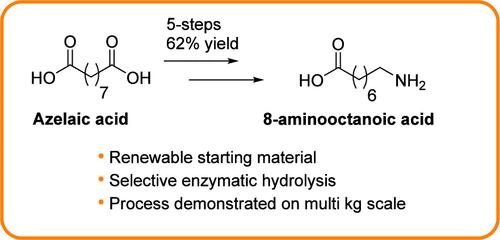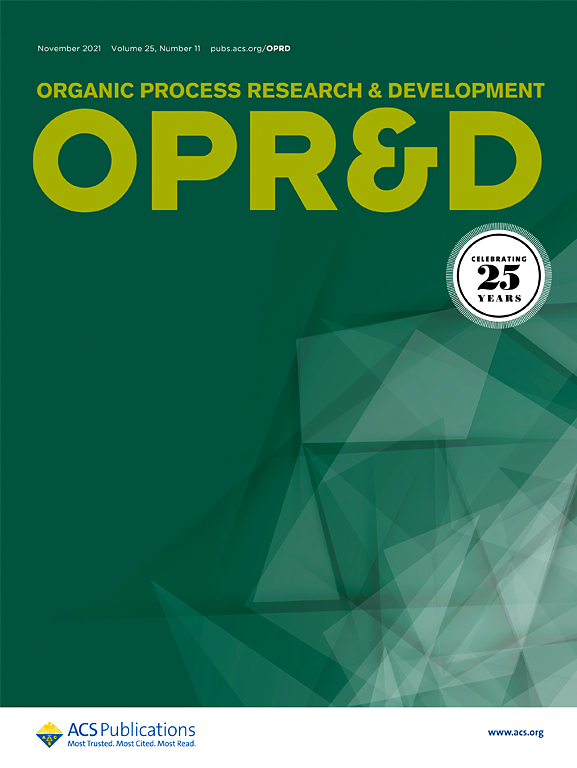Process Development and Scale-Up of a Novel Route to 8-Aminooctanoic Acid
IF 3.5
3区 化学
Q2 CHEMISTRY, APPLIED
引用次数: 0
Abstract
A robust and scalable process for the production of 8-aminooctanoic acid has been developed. Starting from commercially available azelaic acid, the target compound was obtained in four steps in a 62% overall yield. The process starts with a Fischer esterification, followed by a highly selective enzymatic hydrolysis of dimethyl azelate to methyl hydrogen azelate. Ammonolysis of the latter using aqueous ammonia and subsequent Hofmann rearrangement yields 8-aminooctanoic acid. The scalability of the process has been demonstrated through the successful production of 25 kg of 8-aminooctanoic acid (5 kg batches). Furthermore, a proof of principle has been demonstrated for a further streamlined process in which the first three steps are telescoped.

8-氨基辛酸新途径的工艺开发与规模化生产
开发了一种稳定、可扩展的8-氨基辛酸生产工艺。从市售的壬二酸出发,分四步得到目标化合物,总收率为62%。该过程开始于费舍尔酯化,其次是高选择性的酶水解二甲基氮化酸甲酯氢。后者用氨水氨解,然后霍夫曼重排,得到8-氨基辛酸。该工艺的可扩展性已通过25公斤8-氨基辛酸(5公斤批次)的成功生产得到证明。此外,还证明了一个进一步简化的过程的原理,其中前三个步骤被压缩。
本文章由计算机程序翻译,如有差异,请以英文原文为准。
求助全文
约1分钟内获得全文
求助全文
来源期刊
CiteScore
6.90
自引率
14.70%
发文量
251
审稿时长
2 months
期刊介绍:
The journal Organic Process Research & Development serves as a communication tool between industrial chemists and chemists working in universities and research institutes. As such, it reports original work from the broad field of industrial process chemistry but also presents academic results that are relevant, or potentially relevant, to industrial applications. Process chemistry is the science that enables the safe, environmentally benign and ultimately economical manufacturing of organic compounds that are required in larger amounts to help address the needs of society. Consequently, the Journal encompasses every aspect of organic chemistry, including all aspects of catalysis, synthetic methodology development and synthetic strategy exploration, but also includes aspects from analytical and solid-state chemistry and chemical engineering, such as work-up tools,process safety, or flow-chemistry. The goal of development and optimization of chemical reactions and processes is their transfer to a larger scale; original work describing such studies and the actual implementation on scale is highly relevant to the journal. However, studies on new developments from either industry, research institutes or academia that have not yet been demonstrated on scale, but where an industrial utility can be expected and where the study has addressed important prerequisites for a scale-up and has given confidence into the reliability and practicality of the chemistry, also serve the mission of OPR&D as a communication tool between the different contributors to the field.

 求助内容:
求助内容: 应助结果提醒方式:
应助结果提醒方式:


